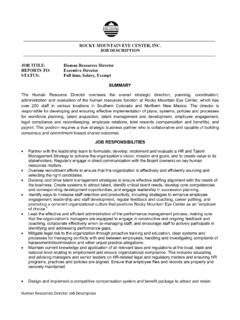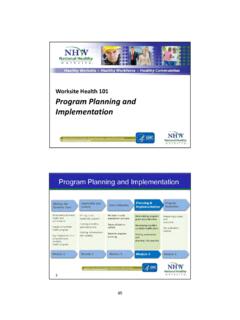Transcription of Roles and responsibilities of implementation members
1 Roles AND responsibilities OF implementation TEAM members As implementation teams are unlike other conceptions of teams in that members both develop and implement a strategic vision, it is likely that implementation teams are also different from more traditionally studied teams in how they function. For example, because large-scale reform often requires changes at all organizational levels, an implementation team would be responsible to ensure that individuals across and down the organization with competing interests implement a team s strategic plan. Therefore, to ensure buy-in and increase the chance for fidelity of implementation , the plan would likely need to reflect these multiple constituencies views (Bunker & Alban, 2002). As such, more and different types of attention may need to be paid to the composition of an implementation team (Higgins, Weiner, & Young).
2 Provide leadership to establish the vision and purpose of intervention to be implemented and to support school-level implementation . Leaders should develop buy-in for implementation from key level leadershipDistrict level leadershipSchool level leadership Provide policy ( , in authority to make decisions about which practice to choose for implementation ). Create stakeholder group to identify a state vision for the intervention, if applicable. Support reorganization of units with SEA to support state vision. Provide supports for schools to identify specific interventions and implement them. Develop district shared vision for intervention implementation . Provide supports for schools to identify specific interventions and implement them. Provide a list of recommended interventions. Create stakeholder group to develop tools to support implementation .
3 Establish a school implementation team. Reach out to district to advocate for the school/obtain necessary resources and support for successful academic officers; state administrator(s) responsible for literacy initiativesExecutive directors of K-12 schools that oversee principals; facilitators (provide PD and coaching )PrincipalsProvide support to ensure implementation team are aware of background information , theory, philosophy values; introduce the components and rationales of key practices; provide opportunities to practice new skills and receive feedback in a safe training environment (Fixsen, et al., 2009).Chief Academic Officers; state administrators(s) responsible for literacy initiativesExecutive directors of K-12 schools that oversee principals; facilitators (provide PD and coaching );FacilitatorProvide craft information along with advice, encouragement, and opportunities to practice and use skills specific to the academic officers; state administrator(s) responsible for literacy initiativesDistrict-level facilitators (provide PD and coaching )FacilitatorProvide technical assistance at implementation site to actively work to implement the intervention with fidelity and good effect (Fixsen, et al).
4 Chief academic officers; state administrator(s) responsible for literacy initiativesDistrict-level facilitators (provide PD and coaching )FacilitatorImplement and support school-level academic officers; state administrator(s) responsible for literacy initiativesDistrict administratorsClassroom/intervention teachers from each level; instructional coaches; guidance counselors; school administrator literacy resource teachers; facilitatorAssess key aspects of the overall organizational performance ( , school performance and provide data to support decision making to assure continuing implementation of the core intervention components over time (See, Fixsen, et al.; Horner et al., 2004; Huber et al., 2003; Khatri & Frieden, 2002).Facilitator; classroom/intervention teachers (representatives from different grades or content areas) instructional coaches; guidance counselors; school administrator, literacy resource teachers; facilitator; data coaches, site-based decision making team memberPractical ConsiderationsRoles and responsibilities of implementation team members evolve through the phases of intervention and implementation Considerations for involving parents, community members , and students in various stages of the process can be useful ( , assessing key aspects of organizational performance for planning and implementation of interventions in specific areas).)
5 Instead of focusing a particular individual s fit or talent base, it might be better to focus more on the kind of role or position being filled (Higgins, Weiner, & Young, 2011). Distributed leadership approach should be used at all levels (Duffy & Scala, 2012). To ensure buy-in and increase the chance of fidelity of implementation , the views of multiple constituencies across and down the organization should be reflected (Higgins, Weiner, & Young, 2011). Form teams that have wide-representation of both individuals who possess different organizational experience. The different positions and experience that different team members possess may grant them legitimacy (Hackman & Edmondson, 2008) in the eyes of the individuals implementing the intervention.











